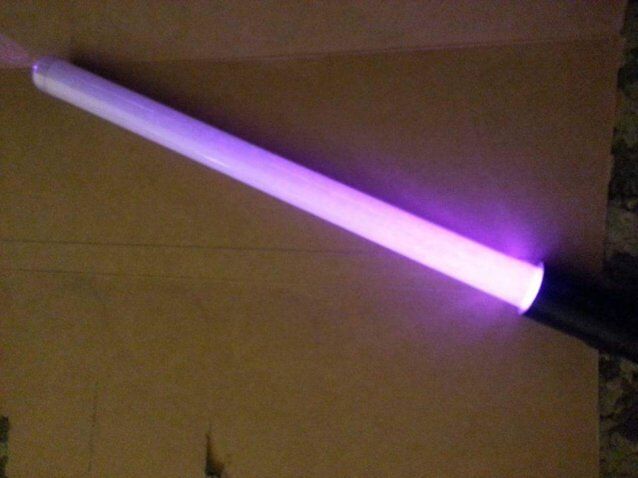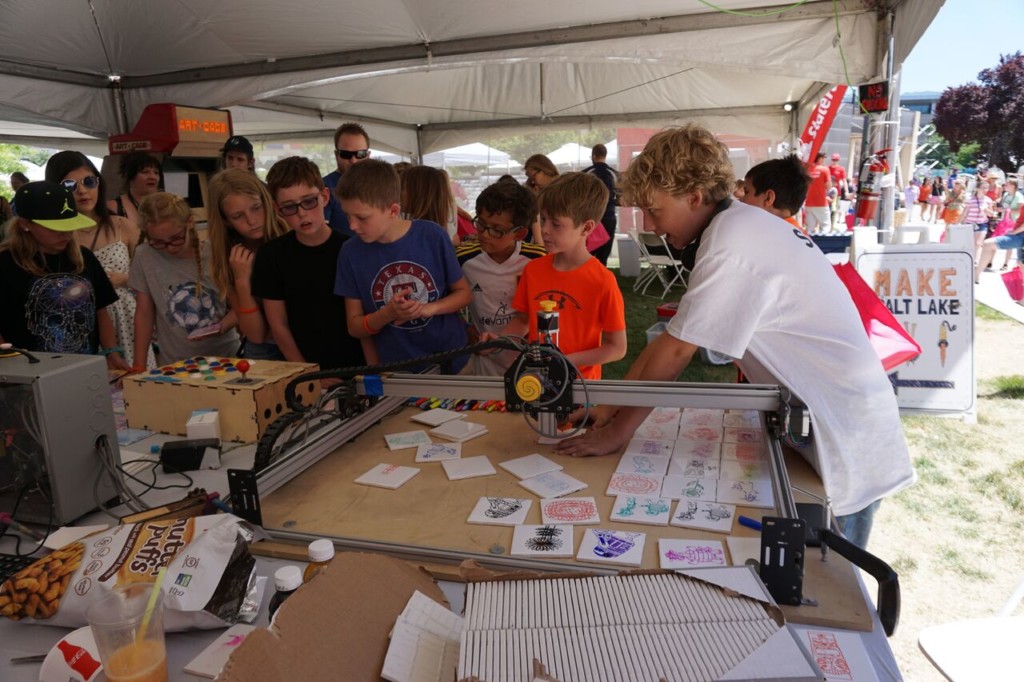As a kid, Michael Beck already was inspired to be a maker. “My grandfather was a cabinet maker and he taught me woodworking; my dad and grandfather got me into the try everything mindset,” he says. “I love taking raw materials and making something, be it a model train layout, knitting a scarf, or making a website to inventory my model train collection.”
Beck’s father has been a model train enthusiast for as long as he can remember. “My dad and I have pretty much bonded over model trains,” Beck recalls. “When I came to Utah, I finally had a place to build my own model train layout. I describe myself as a serial hobbyist.” In addition to his father and grandfather, Beck rattles off a list of his favorite makers, some of whom are well known in the broad makerspace community: Adam Savage, Rob Cockerham, Simone Giertz, Luke Towan and Plasmo, among others.

For the Art and Technology venue at this year’s Utah Arts Festival, Beck has crafted a dry erase moving draw table. “I told him that my favorite part was that the design is there and then gone,” Beth Sallay, Art and Technology coordinator, explains. “Nothing permanent. You can take a picture but that isn’t the same as being there – kind of like those art designs that are made to blow away.”
The objective at Make Salt Lake, which is the main organizer for the numerous activities at Art and Technology, is simple. Even if there are no detailed plans to make something, no one should ever be dissuaded from a project.

Last year, Beck did a harmonograph, which was the older version of the Hasbro Spirograph toy introduced during the mid-1960s. Beck’s harmonograph used 7.5-pound pendulum weights to produce geometric drawings of mathematical roulette circles and curves, using a roller-ball pen to create images on paper. Sallay says that Beck and the others always are looking to improve on the crafts and the demonstrations they provide to festivalgoers each year.
Likewise, Brad Midgley continues to tweak a low-cost portable air quality sensor that connects to WiFi. The devices, built from parts with a total cost about $30, are a low-cost option in how air quality data is collected, analyzed and utilized for policy purposes.
Midgley, who demonstrated the sensor for the first time two years ago at the festival, talks about how it continues to be tweaked. “It helped a lot to have another developer take interest and work on improving the measurements for temperature and humidity,” he explains. “The designs are published and the project is open source. There are still really tricky problems that cause the sensor to stop working and require a reboot every few weeks. We are looking at ways to get around this.”

When Sallay participated in the festival for the first time, she decided to make a small pinball table, which is returning this year better than ever. As she explains in a MakerShare online post, “I was sent a picture of my nephew from the Houston Children’s Museum playing with a reconfigurable pinball table on pegboard with dowels and rubber bands.” She built it with two layers of pegboard and a quarter-inch wood blocks scattered in between so that the dowels don’t lean. Sallay bought miscellaneous toys at local thrift stores and lopped off the heads of the toys and old Pez dispensers, which were then glued to springs and dowels and, after more research, spinners and the toys were attached to bumpers. She used a bike tire around the flippers but later when the contact cement wore out I switched to rubber bands.
“I didn’t know how it would be received with all of the other distractions from the festival and when I got there after work there was a crowd of kids playing with it,” she says. “They stayed there most of the weekend showing everyone how to play it, how to get up the ramp and hit the bell.”
Sallay’s point is that any effective makerspace always will be and should be collaborative. “I can’t take 100% credit for anything,” she adds. “This is all with the help of the people walking by offering advice and the participants of the festival playing with my (our) toys and suggesting improvements.”

Likewise, Sallay, who is not a musician, wanted to build a programmable music box or glockenspiel, as shown at Instructables.com. After trial and error and suggestions from her colleagues, the programmable devices return to the festival this year after last year’s enthusiastic response. There also will be a simply fashioned wind tunnel comprised mainly of an inexpensive fan and a cylinder packed with 1,200 straws which participants can test with paper airplanes.
Indeed, humility and elegance of simple, low-cost designs are why the Art and Technology venue always is packed with kids and visitors, who embrace quickly the opportunity to make something on the spot and take home as a souvenir of the festival, at no charge. Make Salt Lake arranges a storehouse of supplies where kids and other festivalgoers will make and take home art pieces including Brush Bots, light sabers, cyanotype prints and customized art tiles. Last year, more than 9,000 pieces were made during the festival’s four days.

The make-and-take objects are effective examples of simple technology that once mastered can be leveraged for more complex projects. And, the material cost per object ranges from 50 cents to less than $3 (at no additional cost to participants).The Brush Bots are tiny skittering robots with the simplest working parts that are barely more than a toothbrush head, motor and battery. Participants can select their own cutouts from an array of animal shapes. The Brush Bots are durable, even accounting for their size and simple construction. Kids can assemble these in a matter of a few minutes. As a comparison, a brush bot kit at a bookstore costs at least $12.
Also available will be cyanotype printing, which actually represents a photographic print process technology discovered in the mid-19th century and was widely used well into the 20th century for reproducing notes and architectural diagrams such as those in blueprints. Many contemporary artists have adapted the fairly inexpensive process which generates a cyan-blue print using two chemicals: ammonium iron (III) citrate and potassium ferricyanide. Participants will be able to make and take home a print on paper that has been coated and exposed to the sun. The biggest expense is the paper.

The miniature light sabers are back for a fifth year with bright nighttime color effects. The crew built battery holders and kids will add the battery, select the color of the LED crystal, decorate them and take them home. It’s a quick project that can be accomplished in minutes while offering a basic lesson in circuitry and how LEDs work. Most kids can assemble the light sabers in 3 minutes or less. Art tile supplies along with Sharpies and rubbing alcohol will be provided so that festival visitors can make their own designs.
On Friday, June 21, as part of the festival’s Women Who Rock! day theme, women engineers from the locally based CodeDevs group, which empowers young female students through technology education, will lead a coding workshop at the venue.
Volunteers at Make Salt Lake as well as those assigned by festival organizers help kids, as young as three, four or five, and tech-adverse adults learn to make things they believe they could not accomplish. Sallay adds that festival volunteers enjoy the experience so much they become members of Make Salt Lake.

Beck says that he always learns by hands-on experience. “I love to share the fascination of swinging, pushing making your own path to learning,” he explains. “I love to experiment with stuff.”
Beck says he enjoys visiting the Exploratorium in San Francisco. “Its whole mission is to teach by encouraging people to interact with the displays. You crank cranks, push buttons and experiment with things that you know nothing about,” he says. “Life is a laboratory. Learning in a classroom is important, but it is also important to take that knowledge and apply it to a problem.”

For $50 per month, members can use the various shops and services at Make Salt Lake, which operates out of a warehouse at the Utah Arts Alliance building just west of downtown. These include a fully equipped wood tool shop with lathes, drills, saws and other devices. Members can be trained by master carpenters, who can assist them on proper uses of the machinery. The metal shop is equipped to gain experience for MIM (metal injection molding) certification.
For more information about all events, see the Utah Arts Festival website. Ticket information can be found here.

